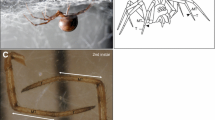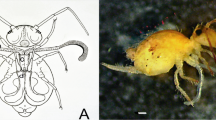Abstract
Lyriform slits sense organs (LSSO) are a precise assembly of stress detecting cuticular slit sensilla found on the appendages of arachnids. While these structures on the legs of the wandering spiderCupennius salei are well studied in terms of morphology, function and contribution to behaviour, their distribution on pedipalps and spinnerets of spiders is not well explored. A study was therefore carried out to observe the distribution of LSSO on pedipalps and spinnerets of some spider species. Haplogyne spiders belonging to familyPholcidae have a simple complement of LSSOs represented by one or two LSSOs on their femur. The entelegyne spiders possess a complex assembly of LSSOs on the distal segments of their pedipalps. Various types of LSSOs are found on the pedipalps indicating a capacity for analysis of complex cuticular stress. It is suggested that the complexity of LSSOs on pedipalps of entelegyne spiders relates to courtship and spermatophore transfer and may help in reproductive isolation. Lack of LSSOs on the distal segments of pedipalps leads us to infer that unlike legs, pedipalps are less likely to receive vibratory input through their distal segments.
Spinnerets have a relatively simple complement of LSSOs. One LSSO is found only on anterior spinnerets and it is a common feature observed among spiders, irrespective of the variations in web building behaviour. The orb-weaving araneidArgiope pulchella, however, has two LSSOs on the anterior spinneret. As non-web builders and orb weavers do not differ markedly in terms of LSSOs on the spinnerets and LSSOs are simple in nature (type A), it is likely that spinning and weaving are not largely regulated by sensory input from LSSOs on the spinnerets.
Similar content being viewed by others
References
Barth F G1978 Slit sense organs: “Strain gauges” in the arachnid exoskeleton;Symp. Zool. Soc. London 42 439–448
Barth F G 1985a Neuroethology of spider vibration; inNeurobiology of arachnids (ed.) F G Barth (Berlin: Springer) pp 203–229
Barth F G 1985b Slit sensilla and the measurement of cuticular strain; inNeurobiology of Arachnids (ed.) F G Barth (Berlin: Springer) pp 162–188
Barth F G 2002A Spider's World: senses and behaviour (Heidelberg: Springer) pp 394
Barth F G, Ficker E and Federle H -U 1984 Model studies on the mechanical significance of grou** in compound spider slit sensilla;Zoomorphology 104 204–215
Bleckmann, Barth F G 1984 Sensory ecology of the semiaquatic spider (Dolomedes triton) II. The release of predatory behaviour by water surface waves;Behav. Ecol. Sociobiol 14 303–312
Bristowe W S and Locket G H 1926 The courtship of British lycosid spiders and its probable significance;Proc. Zool. Soc. London 317–327
Craig C L 2003Spider webs and silk: tracing evolution from molecules to genes to phenotypes (New York: Oxford University Press) pp 230
Foelix R F 1996Biology of spiders (New York: Oxford University Press) pp 330
French A S, Torkkelli P H and Seyfarth E-A 2002 From stress and strain to spikes: mechanotransduction in spider slit sensilla;J. Comp. Physiol A188 739–752
Gorb S N and Barth F G 1996 A new mechanosensory organ on the anterior spinnerets of the spiderCupennius salei (Araneae, Ctenidae);Zoomorphology 116 7–14
Kullman E 1972 The convergent development of orb-webs in cribellate and ecribellate spiders;Am. Zool. 12 419
Peters W and Pfreundt C 1986 Die verteilung von Trichobothien and lyraförmigen Organen and Laufbeinen von Spinnen mit unterschiedlicher Lebenwise;Zool. Beitr. NF 29 209–225
Rovner J S 1975 Sound production by nearctic wolf spiders: a substratum-coupled stridulatory mechanism;Science 190 1309
Seyfarth E-A and Barth F G 1972 Compound slit sense organs on the spider leg: mechanoreceptors involved in kinesthetic orientation;J. Comp. Physiol 78 176–191
Tietjen W J and Rovner J S 1980 Trail following in two species of wolf spiders: sensory and etho-ecoloigcal concomitants;Anim. Behav. 28 735
van de Romer A 1980Eine vergleichence morphologisches Untersuchung and dem für die Vibrationswahrnehmung wichtigen Distalbereich des Spinnenbeins, Diplomarbeit, Universität Frankfurt am Main
Author information
Authors and Affiliations
Corresponding author
Rights and permissions
About this article
Cite this article
Patil, B., Prabhu, S. & Rajashekhar, K.P. Lyriform slit sense organs on the pedipalps and spinnerets of spiders. J. Biosci. 31, 75–84 (2006). https://doi.org/10.1007/BF02705238
Received:
Accepted:
Published:
Issue Date:
DOI: https://doi.org/10.1007/BF02705238




